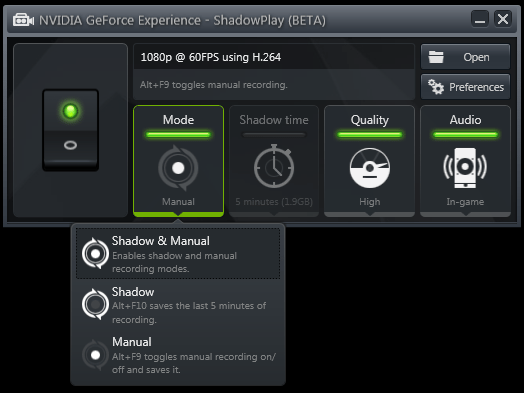

The biggest potential drawback of Game DVR (other than the lack of controls) is that it doesn't always work properly, particularly in more demanding games and on lower spec GPUs (especially integrated graphics). Also, recording can be fairly CPU intensive, and on low-end systems even capturing a 720p video can give you extremely pixelated results.

Video recording (default shortcut of Win + Alt + R) allows you to specify 30 fps or 60 fps recording, as well as standard (720p) or high (1080p) quality, and an audio bitrate, and that's it. It supports UWP games, which many of the other tools don't, but the features and customization options are severely limited. If you're using Windows 10, you already have this, and it can work in a pinch. Like Afterburner, OBS is a good free addition to your software library that you may as well have on hand. It's especially useful if you want to record from multiple sources at once (eg, a webcam, as if you were streaming) and set up a scene. (If you do high quality H.264 encoding on the CPU, be warned that you'll want a fairly potent-6-core/12-thread or more-processor.)Īs it's primarily streaming software, though, OBS isn't your best option for quickly snapping a highlight or a screenshot, but it can record video locally and does so well. One of the big benefits of OBS for streaming is that it allows plenty of custom options, and you can determine how the video gets encoded-on the CPU or the GPU-as well as the codec to use. If you have an AMD card, give it a shot, but consider some of the other options as well. The impact on framerates is pretty small (5-10 percent in most cases), but for more complex streaming setups it can fall short. Like the Nvidia solution, AMD's ReLive utilizes the GPU for most of the encoding, saving your CPU cycles for other stuff. That's probably not really useful, and ShadowPlay's decision to only downscale (eg, from a 4k resolution to a 1080p recording) is possibly better.

ReLive will also respect your resolution setting, upscaling content if necessary, so if you're playing a game at 1080p you can still record at 4k. Even on an RX Vega 64, we would end up with 53-56 average fps videos. If you set ReLive to record a 4k 60fps stream, for instance, you're probably going to drop some frames. Like ShadowPlay, ReLive tends to work OK once you're past the UI, though there are a few noteworthy differences. You have to go into the Radeon Settings application to change bitrates, resolution, shortcut keys, and more. But other elements-like adjusting the settings for your recordings-aren't present.

The Alt+Z default shortcut is the same, only now it pops up a panel on the side of your display, where you can see a few of the settings, as well as access AMD's Chill feature. All the bad things we just said about ShadowPlay's UI? They're basically all present in ReLive as well, and in some ways they're worse.


 0 kommentar(er)
0 kommentar(er)
